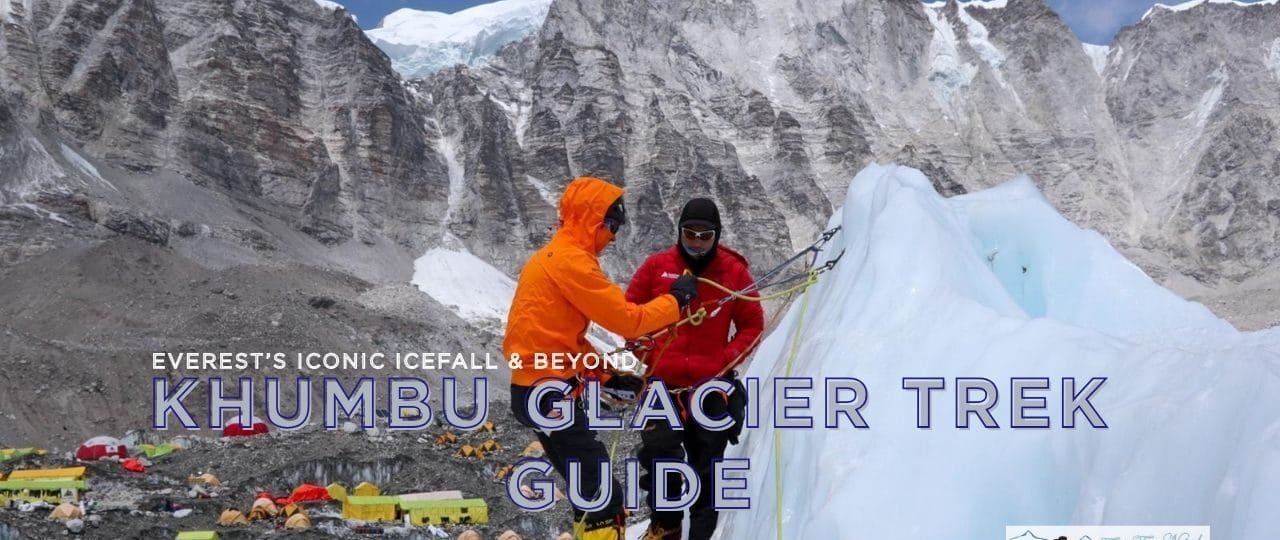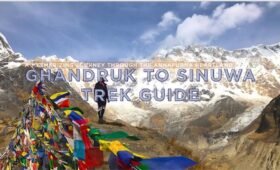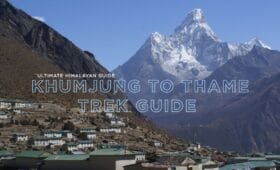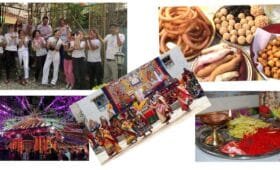The Khumbu Glacier Trek is a legendary route leading to the very heart of the Everest region. It offers mesmerizing views of Mount Everest and an encounter with the famous Khumbu Icefall Trek segment near Base Camp. For trekkers worldwide, stepping onto the glacial terrain of the Khumbu Glacier epitomizes Himalayan adventure—an enticing challenge that complements the classic Everest Base Camp Trek. Whether inspired by the mountaineering feats on Everest or enthralled by Nepal’s mountain culture, the Khumbu Glacier Trek stands as an ultimate odyssey.
This extensive Khumbu Glacier Trek guide delves into every facet of the trek, from detailed itineraries, costs, and route planning to altitude tips, best seasons, and philanthropic travel opportunities with Volunteers Initiative Nepal (ViN). Look no further if you’ve ever yearned for a closer look at the world’s highest mountains while experiencing the vibrant Sherpa community. The Khumbu Glacier Trek merges physical challenges with cultural immersion like no other trail in the Himalayas.
Introduction
1. Introduction: Why the Khumbu Glacier Trek?
Situated in northeastern Nepal, the Khumbu Glacier extends from the slopes of Mount Everest, culminating near its southwestern side. Known for its towering ice pinnacles, labyrinthine crevasses, and the dramatic Khumbu Icefall Trek portion, the glacier shapes the iconic route to Everest Base Camp. As part of the broader Everest Base Camp Trek, the journey to the Khumbu Glacier unveils a majestic panorama of Himalayan peaks—Nuptse, Lhotse, Ama Dablam—and fosters intimate connections with Sherpa culture in villages like Namche Bazaar, Tengboche, and Dingboche.
Statistic: According to the Nepal Tourism Board, ~50,000 trekkers attempt the Everest Base Camp Trek yearly, with the majority stepping on the Khumbu Glacier near Base Camp. However, not everyone takes the time to explore the glacier’s unique features or learn more profound insights into the Khumbu Glacier Trek. Travelers get a front-row seat to Everest’s raw, icy domain by focusing on the glacier.
“I was awe-struck by the sheer scale of the Khumbu Glacier—massive ice towers, the thunderous cracking of shifting ice, and a sense of standing at the doorstep to the world’s highest summit,”
recalls Linda, a 29-year-old trekker from Canada.
Overview
2. A Brief Overview of the Everest Region & Khumbu Icefall Trek
2.1 Geographical Context
The Khumbu Glacier Trek unfolds in the Solu-Khumbu District of Nepal, overshadowed by Mount Everest (8,849m). Its glacial tongue terminates near 4,900m, while the upper glacier merges into the steep southwestern face of Everest. Trekkers approach Lukla, ascending the Dudh Koshi River valley and reaching Everest Base Camp at ~5,364m near the glacier’s edge.
2.2 Cultural Immersion
You’ll encounter Sherpa villages—Namche Bazaar, Phortse, Pangboche, and more throughout the route. These settlements revolve around yak herding, farming, and tourism. Expect to see colorful prayer flags, ancient monasteries (gompas), and the spiritual fervor that underscores the local Buddhist culture. The synergy of mountain vistas and warm Sherpa hospitality underscores every day of the Khumbu Glacier Trek.
2.3 Khumbu Icefall Significance
The Khumbu Icefall Trek portion—the chaotic tumble of ice blocks near 5,500m—draws mountaineers who scale Everest’s southwestern flanks. While standard trekkers typically do not cross the icefall, glimpsing it from Everest Base Camp is a highlight. The icefall shifts daily, with seracs precariously balanced, a testament to Everest’s dynamic environment.
Trek Itinerary
3. Khumbu Glacier Trek Itinerary
Though part of the Everest Base Camp Trek, a specialized focus on the Khumbu Glacier might follow a 12–14 day schedule from Kathmandu. Below is an indicative itinerary:
Day 1: Fly Kathmandu → Lukla (~2,840m), Trek to Phakding (~2,610m)
~30-min mountain flight. ~3–4 hours hiking. Overnight in a teahouse.
Day 2: Phakding → Namche Bazaar (~3,440m)
~5–6 hours. Cross-suspension bridges over the Dudh Koshi. Namche is the Sherpa capital.
Day 3: Acclimatization in Namche
Hike to Everest View Hotel (~3,880m) or Khumjung (~3,790m). Explore local markets.
Day 4: Namche → Tengboche (~3,867m)
~5–6 hours, gentle ascent with mesmerizing Ama Dablam and Everest vistas.
Day 5: Tengboche → Dingboche (~4,410m)
~5–6 hours, passing Pangboche, enjoying close-ups of Lhotse and Nuptse.
Day 6: Acclimatization in Dingboche
Side hike to Nangkartshang (~5,083m) or Chhukung Valley.
Day 7: Dingboche → Lobuche (~4,910m)
~5 hours. Pass the memorial area at Thukla for fallen climbers.
Day 8: Lobuche → Gorak Shep (~5,164m) → Everest Base Camp (~5,364m) → Return to Gorak Shep
~7–8 hours total. Stand on the Khumbu Glacier near Base Camp for your first intimate glimpse of the Khumbu Icefall Trek zone.
Day 9: Gorak Shep → Kala Patthar (~5,545m) → Pheriche (~4,371m)
Early morning ~2 hours to Kala Patthar for Everest sunrise. Descend to Pheriche ~6–7 hours total.
Day 10: Pheriche → Namche Bazaar (~3,440m)
~6–7 hours. Retracing steps downhill with shorter ascents.
Day 11: Namche → Lukla (~2,840m)
~6–7 hours. Potential final glimpses of Everest behind you.
Day 12: Fly Lukla → Kathmandu
Morning flight ~30 minutes.
Khumbu Glacier Trek Duration may vary (10–14 days). Some skip acclimatization or choose alternative vantage points if short on time, but proper acclimatization is crucial to handle altitude near 5,000m.
Trek Distance
4. Khumbu Glacier Trek Distance & Route Clarification
Khumbu Glacier Trek Distance from Lukla to Everest Base Camp is ~62–65 km round trip, though side expansions like Kala Patthar or Nangkartshang add more. The route’s daily distances typically range from ~8–12 km. Many travelers see it as part of the Everest Base Camp Trek, culminating at the glacier near Base Camp.
Khumbu Glacier Trek Route highlights:
If you aim to glimpse the Khumbu Icefall Trek segment, that vantage is near EBC’s edge, as the icefall ascends to Camp I at ~6,000m.
Lukla (~2,840m) → Phakding → Namche → Tengboche → Dingboche → Lobuche → Gorak Shep → Everest Base Camp.
The final approach from Gorak Shep crosses the lower Khumbu Glacier to EBC (~5,364m).
Trek Difficulty
5. Determining Khumbu Glacier Trek Difficulty
Khumbu Glacier Trek Difficulty ranks advanced among standard trekking routes, due to:
- Altitude: Summiting Everest Base Camp at ~5,364m, with side expansions up to ~5,545m at Kala Patthar.
- Length: Typically 10–14 days, demanding consistent multi-hour walks.
- Terrain: The glacier’s final sections can be rocky or icy. However, standard trekking does not cross the more technical sections of the Khumbu Icefall Trek used by climbers.
- Weather: Conditions near the glacier can shift quickly. Sub-zero nights above 4,500m are typical.
Trekkers must adopt a slow approach, schedule acclimatization days, and maintain good hydration. A prior multi-day high-altitude trek is recommended, though novices with strong fitness can succeed with proper pacing and guidance.
Trek Cost
6. Cost Factors: Khumbu Glacier Trek Cost
Khumbu Glacier Trek Cost typically surpasses shorter Himalayan treks, reflecting flights, altitude, longer days, and the remote environment:
Flight
Kathmandu–Lukla round-trip: ~USD 180–200 each way, subject to season and demand.
Food & Lodging
Teahouse rooms: ~USD 3–5 at lower altitudes, rising to ~USD 5–7 near Gorak Shep.
Meal costs: ~USD 25–30 daily, higher near EBC.
Permits
Khumbu Glacier Trek Permits typically include entry to Sagarmatha National Park (~USD 30), local municipality fees (~USD 20), and TIMS (~USD 10–20).
Guide & Porters
~USD 25–30/day for a licensed guide, ~USD 15–20/day for a porter.
Misc
Hot showers (~USD 2–5), Wi-Fi (~USD 2–5), charging (~USD 1–2). Add daily lodging/food/staff wages for any expansions or rest days.
Hence, a typical 12–14-day route might cost ~USD 700–1,200 if you go teahouse style, plus flights. A Khumbu Glacier Trek Package from an agency, including flights, staff wages, permits, and partial meals, could be ~USD 1,200–2,000.
Trek Permits
7. Required Permits & Regulations: Khumbu Glacier Trek Permits
For the Khumbu Glacier Trek:
- Sagarmatha National Park Entry (~USD 30).
- Lukla Municipality Fee (~USD 20).
- TIMS Card (~USD 10–20).
No special restricted permit is needed for the standard route. If exploring beyond standard Everest Base Camp, check local rules. Keep passport copies on you as local police or park officials may ask for permit verification. Agencies often handle these formalities if booking a Khumbu Glacier Trek Package.
Trek Best Time
8. Ideal Season & Khumbu Glacier Trek Best Time
Khumbu Glacier Trek Weathprimaris is primarily consistent with the rest of the Everest region:
Autumn (Sept–Nov)
Crisp skies, minimal rainfall, stable weather. Daytime ~15°C at lower altitudes, sub-zero nights above 4,000m. The peak season for photography.
Spring (Mar-May)
Rhododendron bloom, mild day temps. Occasional showers or afternoon clouds. Good mountain clarity in the mornings.
Winter (Dec–Feb)
There is sub-zero daily above 3,500m, fewer trekkers, and some teahouses close around Gorak Shep. The trek remains feasible if you can handle the cold.
Monsoon (Jun–Aug)
There is high rainfall, flight disruptions to Lukla, and a risk of landslides. Although the region sees fewer crowds, it is typically not recommended.
Thus, the Khumbu Glacier Trek’s Best Time is typically autumn or spring, when stable conditions and scenic vistas converge. Winter suits solitude-lovers, but nights at EBC can drop well below -10°C. Monsoons are the least favored, and they have poor weather reliability.
Accommodation
9. Lodging & Facilities: Khumbu Glacier Trek Accommodation
Khumbu Glacier Trek Accommodation primarily relies on teahouses:
Lower Region (Lukla, Phakding, Namche)
Dozens of lodges with options from budget rooms to slightly more upscale. Free Wi-Fi in some places.
Mid Region (Tengboche, Dingboche)
Cozy teahouses but fewer. Communal dining halls. Basic hot showers at extra cost.
Upper Region (Lobuche, Gorak Shep)
Fundamental lodging, limited capacity. Room cost can be ~USD 5–7. Given the transport challenges, meals are more expensive.
In peak seasons, arrive early to secure a room near Lobuche or Gorak Shep. Warmer sleeping bags are essential as teahouse rooms are unheated. Despite the remote environment, the staff excellently provides hearty meals (dal bhat, noodles, momo, local bread) with occasional Western staples.
Trek Weather
10. Seasonal Weather Insights: Khumbu Glacier Trek Weather
Khumbu Glacier Trek Weather can shift dramatically as you ascend:
- Below 3,500m: Mild days, ~10–20°C in autumn or spring.
- 3,500–4,500m: Crisp days, sub-zero nights. Thin air intensifies sun exposure, so sunblock is crucial.
- Above 4,500m (Lobuche, Gorak Shep): Typically 0–5°C daily, 10°C or colder at night. Snow is possible year-round.
Expect more significant temperature swings in winter. In monsoon, precipitation can hamper flight reliability to Lukla, plus clouds may obscure peaks. Autumn generally yields the most precise, windiest days, especially near midday on the glacier.
FAQs
11. The Seven Most Common Questions
What is the Khumbu Glacier Trek Distance?
Typically, it is a ~62–65 km round trip from Lukla to Everest Base Camp and back, with expansions for vantage hikes.
How difficult is the Khumbu Glacier Trek Difficulty?
Advanced moderate. Daily ascents culminate at ~5,364m for EBC. Proper acclimatization is essential.
What’s the typical Khumbu Glacier Trek Duration?
~12–14 days from Kathmandu, factoring in Lukla flights and ~2 acclimatization days.
How much does the Khumbu Glacier Trek Cost?
A minimal approach might be ~USD 700–1,200 for a 12–14-day teahouse experience. A Khumbu Glacier Trek Package with an agency can be ~USD 1,200–2,000.
When is the Khumbu Glacier Trek Best Time?
Autumn (Sept–Nov) or spring (March). Winter is cold but feasible, and the monsoon brings heavy rain and cloud cover.
Do I need special Khumbu Glacier Trek Permits?
Standard Sagarmatha National Park (~USD 30), local municipality fee (~USD 20), plus a TIMS card (~USD 10–20). There is no special restricted permit for the standard EBC route.
Is the Khumbu Icefall Trek portion included for standard trekkers?
Not exactly. You can see the icefall from Everest Base Camp, but crossing it is mainly for climbers heading to advanced camps. Trekkers typically remain at or near Base Camp for safety.
Trek Tips
12. Additional Advice: Khumbu Glacier Trek Tips
12.1 Physical Prep & Altitude Strategy
- Training: Incorporate cardio (running, cycling), plus day hikes or stair climbing with a loaded backpack.
- Acclimatization: Insert rest days in Namche (~3,440m) and Dingboche (~4,410m). Watch for altitude sickness symptoms.
12.2 Minimizing Environmental Footprint
- Carry Reusable Bottles: Use water filters or boiled water from teahouses to reduce plastic waste.
- Trash: Pack out your garbage and use designated bins if available.
- Cultural Respect: Always ask before photographing local people, remove shoes in monasteries, greet with “Namaste.”
12.3 Navigating Everest Base Camp
- Side Trips: Kala Patthar for panoramic sunrise or the glacier’s vantage from Pumori’s viewpoint.
- EBC: ~5,364m, no permanent settlement. Teahouses in Gorak Shep or Lobuche.
- Khumbu Icefall: Visible from EBC’s edge but unsafe for casual crossing.
Testimonials
13. Khumbu Glacier Trek Reviews & Testimonials
Many Khumbu Glacier Trek Reviews revolve around the emotional high of seeing Everest up close and walking on or beside the glacier:
Marina’s Experience:
“I’d done a few Himalaya treks, but the Khumbu Glacier Trek was extraordinary. The sense of epic scale and the daily glimpses of massive ice walls made me appreciate the Sherpas’ resilience. Reaching EBC felt surreal.”
Local Insight: Lodges near Lobuche or Gorak Shep note that visitors often arrive in awe, describing the glacier’s color changes at dusk or the eerie sounds of shifting ice.
Trekkers also highlight the personal achievement gained from braving altitude, forging new friendships en route, and glimpsing the Khumbu Icefall Trek portion (from a safe vantage). Negative feedback mainly concerns unpredictable Lukla flights, cold nights, or crowds in peak season.
Conclusion
From the pastoral approaches of Lukla to the formidable terrain of Khumbu Glacier, the Khumbu Glacier Trek channels both the aspiration of Everest-bound climbers and the welcoming spirit of the Sherpa community. By focusing on the glacier itself, you grasp an unparalleled perspective on the world’s highest mountain region—witnessing the Khumbu Icefall Trek zone near Base Camp and forging a deeper connection with Himalayan culture.
Make a Double Impact with Volunteers Initiative Nepal
Volunteers Initiative Nepal (ViN) merges your Himalayan dream with local empowerment. Their charity trekking and travel tours channel all proceeds into community development. Through ViN, each step of your Khumbu Glacier Trek fosters educational, healthcare, and sustainable livelihood projects across Nepal’s remote areas. It’s an adventure that resonates beyond personal gain:
- Share: Encourage friends, family, and social networks to adopt philanthropic trekking, bridging adventure tourism and social betterment.
- Volunteer: Contribute time, teaching, medical skills, or environment-based expertise to local communities.
- Intern: Integrate research or academic goals with tangible on-site improvements in remote villages.
- Donate: Even small sums accelerate critical school building, scholarship programs, or healthcare expansions.
Namaste—and may your footsteps along the Khumbu Glacier Trek unify your exploration with meaningful local empowerment, forging a future where travelers and Himalayan communities advance together.
Additional Guidance
Extended Practical Guidance & Final Inspiration
1. Seasonal Nuances
- Autumn (Sept–Nov): Crisp, stable, busiest. Ideal for photographers.
- Spring (Mar-May): Rhododendron-laden hills, decent clarity, blossoming flora.
- Winter (Dec–Feb): There are fewer trekkers and freezing nights in Lobuche/Gorak Shep; some teahouses might shut.
- Monsoon (Jun–Aug): Lukla flights are often delayed, and muddy trails and clouds hamper mountain views.
2. If You Have More Time
- Gokyo Lakes: Explore the Gokyo Valley, crossing Cho La pass to rejoin the EBC route for a more comprehensive Everest circuit.
- Cultural Immersion: Spend an extra day in Khumjung, visit the Hillary School, or take a side trip to Pangboche monastery to see relics.
3. Potential Hurdles
- Altitude: The route climbs over 5,000m, so plan rest days at Namche or Dingboche. Keep hydrated and watch for headaches and dizziness.
- Flight Reliance: Kathmandu–Lukla flights can be delayed by weather—factor in a buffer day or two.
- Teahouse Congestion: Autumn can see full lodges. Book or arrive early in Lobuche/Gorak Shep.
4. Post-Trek Options
After returning from EBC, many travelers:
- Relax in Namche: Enjoy German bakeries, local craft shops, or short vantage hikes.
- Descend to Lukla: ~2–3 days. If time allows, consider a side route via Phortse or a visit to Thame.
- Return to Kathmandu: Explore heritage sites and thanks-giving blessings, or finalize volunteer stints with ViN.
By merging the Khumbu Glacier Trek with philanthropic synergy, you transform your high-altitude journey from a personal triumph into a catalyst for communal empowerment. The route’s synergy of glacial wonders, cultural immersion, and charitable growth fosters a once-in-a-lifetime memory. Embrace the “double impact” approach: standing on the edge of the Khumbu Icefall Trek while fueling better livelihoods for the people who call Everest home.




